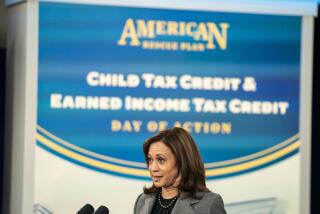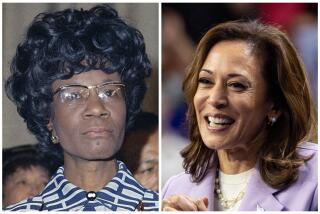Planned Parenthood Boosted by Aggressive Leadership
NEW YORK — She remembers the long rides from St. Louis to Mississippi in the 1950s, the conductor taking her small hand and helping her off the train at Canton, where her grandparents lived.
She remembers the “white” and “colored” signs and the segregated movie theaters of the Deep South where she sat in the balcony because she was black.
She remembers the sermons of her mother, a minister of the fundamentalist Church of God, who spoke out against both sin and discrimination and prayed her little girl would grow up to be a missionary-nurse.
Hell fire and brimstone were the underpinnings of her mother’s faith, but she recalls too, more fondly, a religion of redemption; it was this hopeful image she carried off to college at age 16 and into adulthood.
Still, it might have seemed unlikely, in those girlhood days in St. Louis, that Faye Wattleton would evolve into a pioneer, a crusader, a media star and a rebel of sorts--as the first black president of the Planned Parenthood Federation of America, and, in that role, one of the nation’s most visible advocates of women’s right to choose abortion.
Her mother, Ozie, still lives in Atlanta, in her mid-70s, ready to awaken the faithful to the dangers of drinking and smoking and dancing and moviegoing, not to mention abortion.
From time to time, members of the local anti-abortion group invite Ozie Wattleton to speak at a public meeting, hoping her beliefs will lead her to disavow her daughter’s work.
She has simply refused. “I’m faithful to my own principles,” she told her daughter, “but I’m not going to be drawn into a place that it would be harmful to you.”
Wattleton, now 45, took over Planned Parenthood’s reins in 1978, reshaping it from a low-profile network of family planning clinics into one of the country’s most aggressive proponents of women’s rights. Now, its 800 clinics in 47 states serve nearly 4 million people annually, an increase of almost 3 million during Wattleton’s tenure.
Her first step was to throw the national machinery into high gear. “It was prophetic,” she recalls, “that I felt this was the direction we would have to go, without knowing we were nearing the Reagan years. But I saw the growing political opposition on the local level.”
Wattleton set up the federation’s first Washington office to lobby Congress and pledged to fight for the right of poor women to have access to safe abortion despite cuts in public aid. She hired poll-takers and media experts. She created a team of nine vice presidents to streamline national policy-making.
There were other problems. Some black groups held the view that birth control and abortion were black genocide in disguise, a suspicion that Wattleton’s election helped allay. “Every once in a while, the view does surface, but not often,” said an aide.
Feminists had been critical too. Run by white men and backed by money from population control agencies, Planned Parenthood was considered “elitist” and “too cozy with the medical profession and the drug industry,” said author Barbara Seaman, a founder of the women’s health movement.
In the early days of the birth control pill, Seaman said, many feminists were concerned that Planned Parenthood was placing population control above the health of women. “There was an attitude that poor women were too ignorant or too unmotivated to use middle-class methods of contraception like the diaphragm, and such decisions were best left in the hands of the authorities, the doctors.”
Naming a black woman as president of Planned Parenthood was “a stroke of genius,” Seaman said. “Wattleton has helped to put the federation on a different track, emphasizing informed consent and throwing out the old anti-Populist image.”
Now, with the Supreme Court taking a new look at its 1973 abortion decision, Wattleton has taken Planned Parenthood into an active coalition with the National Organization for Women and other pro-choice groups. This summer, NOW president Molly Yard and Wattleton spoke in tandem on so many television programs that some viewers began to term their appearances “The Faye and Molly Show.”
It has been a long trip. Indeed, “an odyssey,” Wattleton says, sitting in her white-walled office in Mid-town Manhattan. In a minimalist setting, a display case carries some signposts from her journey; a photo of her teen-age daughter Felicia; a number of humanitarian awards and honors; her own photo on a magazine cover, carrying the logo: “The 100 Most Powerful People of the 80s.”
Cartoon Illustration
Prominently displayed is a two-panel cartoon of a pregnant woman and a child. An arrow points to the woman’s belly, labeled “Property of the U.S. Justice Dept.” In the next panel, an arrow points to the child, labeled “Property of the Private Sector.”
The drawing points up Wattleton’s concern for both abortion rights and child care.
In her college days at Ohio State, she worked part time in a children’s clinic in Columbus and saw, for the first time, a steady stream of battered, unwanted children. A few years later, while a Columbia graduate student and working as a nurse in Harlem Hospital, she witnessed the death of a 17-year-old girl after a botched abortion. By then, harsh reality had overshadowed her fundamentalist upbringing.
But she and her mother never had a showdown. “I left home too early for that and never had those late-adolescent years of conflict, when you rebel against all of the restrictions you’ve grown up with.”
Mother and daughter did reach an understanding, she says. “My mother had to resolve she was not going to convert me, and I had to resolve it was OK for my mother to hold on to her views--that I didn’t need her approval to validate every aspect of my life and work.”
When selected as Planned Parenthood’s president in 1978, she moved to New York. Now, 11 years later, she has become accustomed to whizzing about the country non-stop, regardless of death threats from radical antiabortionists.


